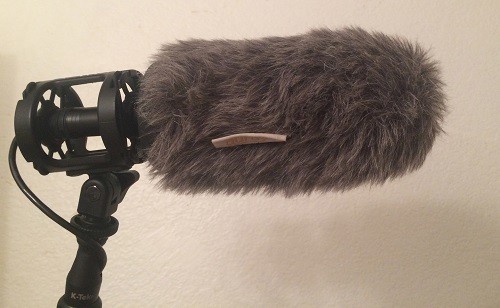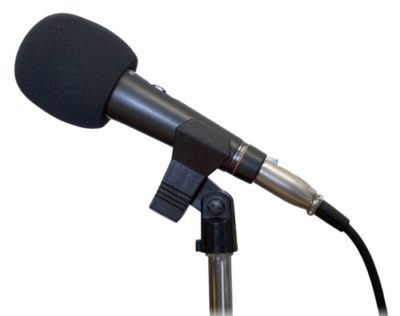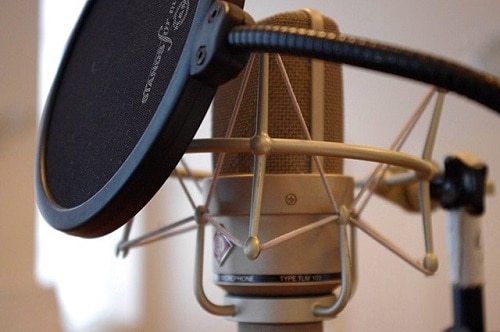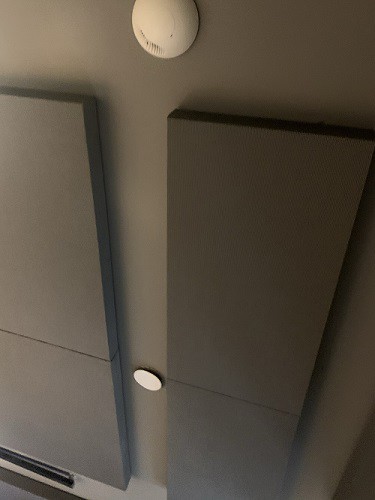How To Cut Out Back Ground Noise On Camera Mic
Whether you're on stage or in the studio, whether y'all're micing a singer, acoustic guitar, guitar amp, or drums, 1 question which every audio engineer should ask himself will always exist of crucial importance for practiced sound is: "how to reduce the groundwork racket on a mic to get the best sound?" Not every microphone is the same, not every room is the same, not every performer is the same. That's why we will give yous several tips on how to go rid, or at to the lowest degree, reduce microphone background noise in live functioning or when recording music, whether you use dynamic mics or condenser mics.
To go rid of background noise on a microphone: you need to eliminate ambient noise sources. Move noisy equipment further abroad from the mic. Close windows and doors to reduce route noise. Movement your microphone away from computer fan and use a pop shield to cake animate sounds when you lot are speaking.
It's not always possible to remove ambience noise entirely, just there are still a number of things you can practise to minimize it. Simply first, let's learn something nearly mic audio dissonance.
Types of Unwanted Sounds
Mic dissonance can be divers as "unwanted sound". Basically, the duration and level of the groundwork sounds determine the characteristics of noise. If y'all want to know how to brand a mic sound amend, it'south important to know the 3 main racket types.
- Broadband Racket (or continuous noise) is the noise in which the acoustic energy is distributed over a wide range of frequencies as it is picked up by a microphone. The sounds like hiss and static noise belong in this category.
- Narrow Band Racket is limited to a narrow range of frequencies. This kind of noise has a constant audio level ordinarily caused by incorrect grounding and poorly shielded cables connecting microphones. Narrow Band Noise is basically any unwanted signal that remains steady over time.
- Impulse Noise includes sharp sounds such as clicks and pops in a mic. It has a high frequency and short elapsing.
* Irregular background noises include unwanted sounds such as rain, traffic, background chat, oral communication etc. These kinds of sounds are very hard to remove because they are produced from many random sounds that differ in frequency and sound volume.
* Electrical racket (60/50 Hz hum), or buzzing sound could also exist a big problem. Brand sure all your recording equipment is continued to the same power strip. Also, you should keep microphone cables away from electricity cables.
*The noise floor is the level of groundwork noises in a signal or the level of dissonance introduced by the sound system.
Offset reducing noise from the very first sound source – your microphone. Here are 9 ways it can be done –
one) Microphone Sensitivity And Gain Setup
Microphone sensitivity is very of import when choosing the right mic for your needs. Normally, information technology's measured with a 1 kHz sine wave at a 94 dB acoustic level (SPL).
You should know that some microphones are more than sensitive than others and the audio quality of it is not really related to its sensitivity. Once exposed to the same sound source, various microphone models might generate totally different audio output levels. A measure out betwixt the microphone'south noise level, clipping bespeak, baloney, and sens defines whether or not a microphone may be a good fit for a specific apply. A microphone with high sensitivity might require less preamp gain. As well, it may have less headroom before clipping than a mic with lower sensitivity. It's also worth keeping in listen that your end result will depend a lot on microphone quality. If you offset with a poor mic, no amount of filters or processing is going to brand it any better or help you reduce background noises and go rid of static.
Dynamic microphones generally take a very depression sensitivity while condenser microphones usually have a higher sensitivity. The microphone indicate level may be easily adjusted to the desired input level with the proper preamp gain. Be aware that each proceeds phase volition include some dissonance into the signal. It's up to you or your audio engineer to make sure that every gain level is adept enough to keep its input dissonance from corrupting the sound bespeak. Proper microphone gain setup should keep dissonance out of your output. Ready the correct input level of your sound source and use balanced audio connections, to foreclose the reasons why a mic would pick upwards everything in the background.
If your mixing desk or audio interface has a microphone boost option, effort turning that off, or all the manner down to keep noise at a minimum.
Keep environmental background noises out of your live operation or sound recording with avant-garde equipment.
2) Microphone Windshield (Windscreen) to Suppress Outdoor Sounds
Cream or fur (Windjammer); actually the combination of these two products are groovy for blocking the noises produced past the air current. It should be placed over the microphone'due south head. This "dead cat" designed accessories will preclude air current interference as well as heavy breathing and pop noises. These windshields offer up to 12dB wind dissonance rejection. All the windscreens would slightly reduce the full level of the microphone book and selectively lower the level of college frequencies. However they reach this with less audio interference from the ambience air and reduce background noise, any microphone yous use with windshield will deliver cleaner sound. Employ it. Also yous may want to check out the Rode Rycote Shotgun Mic on Amazon for outdoor work.
#ad

iii) Pop Filter to Eliminate Unwanted Sounds
If you desire to avoid plosive and sibilance from your recording yous should consider using pop filters for your microphones – click here to read more about popular filters. Information technology is generally not for outdoor use and you tin can meet it usually used in studio / home studio. It is a filter which is placed betwixt a singer / speaker and the microphone. A popular filter comes in a round disc looking object which should be mounted on a mic stand up and has a flexible boom to place it exactly where needed. Looks like a big lollipop. This lollipop eliminates or reduces plosives so the microphone volition not selection upwards an explosion of sound(pop noise) and will help confronting picking up noises from the groundwork as well. Also, it helps keep moisture off the mic, which is good for your equipment. Some microphones, such as the SM58, have a built in pop filter under the metal casing, that does reduce this problem a trivial scrap. A pop filter can also aid to some extent with sibilance on vocals. To go the price of a popular filter I recommend on Amazon, click here
#ad
Cheque out my other post – Exercise dynamic microphones need pop filters?
*Some microphones actually have a pop filter built-in, so you should do your research.

4) How to Stop Picking Up Background Sounds with a Microphone Shock Mountain
Every modern microphone is very sensitive and prone to picking upwards background noise. Shock mounts are a swell way to protect a microphone from shocks and vibration, and if you desire to become the all-time possible performance and audio quality. A shock mountain will effectively reduce microphone handling noise. Utilize shock mounts on mic stands to reduce background noise acquired past tremors and vibrations from the mic stand itself and from people walking beyond the flooring. Cheque out this great microphone and stupor mount for studio work.
#advertisement
At present, when you take a adept sound with minimal background noises from the very beginning, yous can go to the next level of fifty-fifty more mic dissonance reduction. Sound processing.
To check the price of shock mounts on Amazon, click hither
#advert

five) Filters for Mic Static Dissonance, Hiss, Hum and Other Sounds
Filters will non change or add new frequencies to the audio input signal. Filters are often used to highlight the signals in certain frequency range and reject signals in other frequency bands such as those associate with background noises and unwanted microphone sounds.
You should use a loftier laissez passer / low cut background noise filter which removes low-frequency rumble and DC starting time. Ready the frequency control at 10 Hz if you want to eliminate DC beginning just. A harmonic notch filter cutting at fifty Hz or 60 Hz will exist able to ensure that Air conditioning hum is easily removed.
These are five basic filter types:
- Bandpass filter is used in audio systems to carve up a indicate at one frequency or within a band of frequencies from signals at other frequencies.
- Notch or Band-Reject is a filter with the opposite function of the bandpass. This filter is used to reduce groundwork racket by removing an unwanted frequency from a signal while affecting all other frequencies equally little as possible.
- Low-Laissez passer filter permits depression-frequencies and rejects sound signals above the filter's cutting-off frequency. Depression-pass filters are used whenever high frequencies should exist removed from a signal.
- High-Pass is the opposite of the low-pass filter, which rejects signals below its cutting-off frequency. High-pass filters are used in cases when the rejection of low-frequency signals is needed.
- All-Pass (or Stage-Shift) filter type has no effect on the aamplitude of the bespeak. Its function is, without affecting its amplitude, to change the stage of the signal.
The almost popular and can be plant on whatever mixer is a depression cutting (loftier-laissez passer) filter which reduces depression-frequency rumble from an sound or mic signal. Start from 20hz and become up until y'all find the sweet spot without affecting sound source. For example, for male vocals, you lot could get up to 100hz. For a female, up to 120hz. Experiment to go the best possible microphone dissonance reduction. If you want to removed static, these filters can be quite effective.You should also
After we have applied the filters, if background sounds are nonetheless present, we should fine-tune the signal with the equalizer.
6) Equalization to Remove Unwanted Audio and White Racket
What is the equalizer? Equalizer (EQ) is a software or hardware filter that adjusts the frequency of certain frequencies.
What is equalization? Equalization is optimizing frequencies of sound. Through the equalization process, we can increment or decrease the volume of the selected frequency, such as those that are coming from groundwork noises from a mic.
Every sound has its frequency and sure frequencies are louder than others. Because of that, nosotros use an equalizer to "equalize" these frequencies. This means that we will reduce frequencies that are dominant or increment those that are missing in society to achieve the best sound. Using Equalizer is quite easy, especially if it has its own analyzer. With the help of analyzer, you tin can easily meet which frequency is messing your performance and reduce it.
If we're talking well-nigh an sound recording and for example, if that recording of your voice has the so-called white noise (hiss) and your analyzer shows the ascendant frequency of 7khz, simply select and reduce that frequency with your equalizer. You should exist able to gear up the microphone white noise and notice the difference instantly.
On the other hand, if we are talking about live operation, and you exercise not accept a digital mix, you take to rely on your ears. Each tone has its ain frequency. Microphones placed wrongly on a phase will cause feedback upshot and you may too take certain sounds that are more than noticable because of acoustic echo and groundwork noise, only yous tin too use eq to attempt and resolve this too with a process chosen acoustic echo counterfoil. Acoustic repeat cancellation can exist achievable with using some skill with equalization. Practice identifying which frequency is accentuated or missing.
*Every audio engineer will tell y'all that the outset thing you lot should try with EQ is to reduce the level of frequency, not increase information technology.
In whatever case, the dissonance gate is a very useful audio processing application. So, if you lot have the option to apply information technology for live performance (digital mixer, or an external unit), information technology volition significantly assistance yous to reduce background noise. It can also be of bully importance in post product.
Table of common groundwork noises
| PC silent fan | 20-25 dB |
|---|---|
| PC functioning fan | xxx-35 dB |
| Barking dog | 85-120 dB |
| Snoring dog | 50-65 dB |
| Route traffic | 70-80 dB |
| Route traffic (windows closed) | 35-45 dB |
| Air conditioner | 60-65 dB |
| Telephone ringing | 70-80 dB |
| Figurer keyboard | l-lx dB |
| Computer mouse click | fifty-75 dB |
seven) How to Cancel Unwanted Sounds with a Noise Gate
A noise gate is usually used for the reduction of unwanted external sounds and to assist reduce background noise. It allows an audio point to pass through merely when it is above a threshold value. In other words, it is unremarkably used when the level of the audio signal is in a higher place the level of the dissonance. If properly ready, the noise gate will reduce steady noise static from amplifier and hum from the power supply organization and power cablevision without affecting the sound source. With very few adjustments, with the assistance of the gate, you tin get rid of the unwanted background noise or static audio that your microphone picks upwardly, either at the stage or in your home studio. If you are notwithstanding getting mains hum causing audio interference, you could endeavour irresolute over to another power socket.
Noise gate software or hardware normally has five parameters:
- Threshold sets the level at which the gate opens to let the sound go through.
- Ratio is the balance betwixt the original sound and the gated sound.
- Set on sets the time it takes for the gate goes from a closed to an open land.
- Agree permits the gate to be kept in an open state later on the signal level has fallen below the threshold.
- Release is normally used to set how long it takes for the gate to go from fully open up to fully closed. A fast release quickly cuts off the sound. Slower release is interim like a fade out.
*If you set the release to fast it could induce a clicking sound.
8) Racket Reduction Software and Audio Recording
If yous can't find a better solution and yous demand the noise reduction software, be sure that the noise removal process must be advisedly used as it can lead to a loss of audio data. Sometimes it is better to get out some dissonance in the recording than to remove a significant role of your audio fabric.
Audio noise suppression software helps remove background noise from an audio indicate. The goal of any noise suppression process is to have a noisy signal and isolate the make clean sound signal from the noise.
At that place is a lot of noise cancelling software plug-ins on the market. Basically, every noise reduction plugin works according to the same principle. "Get noise print and – apply". The difference is but in boosted parameter settings. Some companies even offering total-featured DAW (digital audio workstation) for sound restoration. For instance, well known Izotope, with its latest rx7 audio editor software for postal service production, offers a range of incredible possibilities for achieving the professional sound. Worth every penny. The complete rx7 audio editor contains De-Noise, De-Click, De-Crackle, De-Hum, De-Plosive, De-Ess, De-Reverb, De-Rustle, De-Wind, Dialogue Isolate, Spectral De-Noise, Vocalisation De-Noise, Rima oris De-Click, EQ Match plug-ins and much more. Really amazing and useful stuff. Other companies that are also prominent with their audio restoration software are Adobe (Audition CC), Acon Digital (Acoustica vii, Restoration Suite), Audacity (free), Sonnox Restore, Waves, Antares (SoundSoap), Zynaptiq (Un-series), Sound Forge, Cedar Studio etc.
You can guess which one is most popular among audio hobbyists. You're right, Audacity. You lot may want to cheque out my Audacity video course here.
Brazenness is actually a gratuitous audio editing software which has a quite decent Noise Reduction tool plug-in, and information technology's available for Windows 10, Windows vii and Apple Mac Bone and Linux operating organisation. There are not as many advanced options as rx7, just it can do the job if you want to capture your operation and remove background dissonance out of your recording.
Using excess noise removal in Brazenness is pretty easy. The showtime thing you lot demand to do is open the plug-in, select a region of your sound recording that contains only the so-called "room tone", or, in our case, dissonance, click on "get noise profile". Select all of the audio from which you lot desire groundwork dissonance removed and after that, but click ok. At the aforementioned time, y'all will hear the improvement in your audio track. If you all the same crave an even meliorate sound, than yous should play with other parameters. It is as well possible to do repeat cancellation if required. This method can be used with recording from a PC sound card, USB interface or other sources such as a potable recorder, mixing console or video photographic camera.
If you are recording from calculator make sure your sound drivers are upward to date, as an out of date driver can be a source of crackles, clicks and other sources of racket. If using Windows 10 or another OS, brand sure everything is updated as thus tin as well crusade noise bug.
To check the price of acoustic noise reduction panels on Amazon, click hither
#advertising

9) Adaptive Noise Reduction and Cancellation Technology
Noise cancellation method uses a reference audio input bespeak which contains only dissonance. This signal is transmitted through an adaptive filter and later decreased from the principal input. This Noise Reduction effect tin quickly reduce background racket such as fans, air conditioners, background conversations, rain, wind etc. Well-nigh any advanced Noise Reduction software contains an adaptive noise cancellation option. Basically, it is very useful for "live" (existent-time) noise removal.
Basically every audio recording contains a sure amount of noise. To produce the best audio recordings, these unwanted sounds must exist removed as much equally possible with ambient noise reduction. Until just a few years ago, ambient noise reduction was a very difficult and expensive process. The new generation of loftier-speed computers equipped with quality audio cards and microphone noise cancelling software has fabricated audio noise removal very like shooting fish in a barrel. There is as well the possibility of using a real-time noise cancelling microphone. These noise cancellation filters are getting better every bit the technology improves. If yous adhere to these tips, you volition keep the mic background noise away from your live performances or studio recordings. At the very least, you will significantly reduce ambient noise in your output signal with microphone noise reduction software. In the end, that's the whole point, right?
Some products you might similar –
Here are some products from Amazon that I have plant helpful in reducing noise –
- Rode Shotgun Mic (this is a great mic and is swell for recording with reduced background racket due to its shock mount. With a windshield, it is peachy for using outdoors too and can help produce recordings with great vocalization quality) #ad
- Popular Filter (this has been very useful for close up vocals and oral communication. Cease pops and other mic noise) #advertisement
- Rode NT1 Mic and pop shield ( this is a bully solution for podcasting, interviews and studio recording. Loftier sound quality likewise) #ad
- Acoustic Noise Panels (constitute these to exist actually good in room we use for podcasting. Reduce microphone groundwork noise in the room and save time post processing) #ad
Picking upwardly keyboard noise on microphone?
How to get rid of keyboard dissonance on a mic: there are a number of things yous could endeavour – pass up the gain, motion the mic further abroad from the keyboard, swap your keyboard out for a quieter one.
How tin can I Stop noise on Blueish Yeti mic?
Bluish Yeti background dissonance fix: to solve this trouble, first check the software settings and drivers are up to date, turn down gain, try irresolute polar design setting also moving the mic away from noise sources such as pc fan etc.
Solving headphone racket on mic?
How to fix microphone picking upward audio from headphones: a few things to endeavor – if using a headset mic, try an external mic that is further away from the headphones; turn done headphone volume, refuse mic gain.
Popular filter or windcat for background racket?
Pop filter or windcat – which is best? It really depends what yous are using them for. Popular filters are better for indoors and cutting out unwanted breathing sounds. Windscreens are meliorate for outdoors and cut down current of air noise.
Pop filter on mic stand?
How to adhere a popular filter to a mic stand: it's a good thought to exercise this considering if your mic is picking upwardly dissonance from a item direction, most pop filter attachments allow you to point it in the direction of the noise, thus helping to block information technology.
If you would like to share this post you can re-create this link and then paste on social media or your blog –
https://churchsoundtips.com/mic-backgnd-noise/
Source: https://churchsoundtips.com/mic-backgnd-noise/
Posted by: chalfantretticuld.blogspot.com


0 Response to "How To Cut Out Back Ground Noise On Camera Mic"
Post a Comment